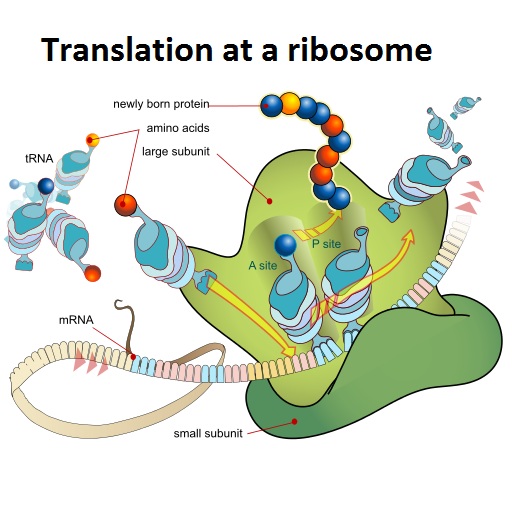Translation of mRNA into Amino Acids
 Building Proteins at Ribosomes.
Building Proteins at Ribosomes.
This lesson includes a bit of awe and wonder. The discovery of the bichemical mechanism of Crick's "Central Dogma" is well documented biological research. A short animation of a mRNA molecule and ribosome in action is followed by some "webquest" research from which students produce a summary diagram on A3 paper with notes to explain translation. There is an excellent online Translation web "game" to assess student understanding at the end.
Lesson Description
Guiding Questions
Francis Crick was the first to suggest a mechanism of converting mRNA into a polypeptide. He thought there must be about twenty 'adapter molecules'. He proposed that little pieces of RNA could bridge the gap between mRNA and Proteins. These molecules were later found and called "tRNA".
What other molecules do you think would be required for Translation (making proteins from mRNA templates)?
Activity 1 Introduction to the function of ribosomes.
This amazing video Animations of translation by Drew Berry shows the work of the Ribosome making a chain of amino acids from a mRNA template.
It was created to raise awareness, educate and promote DNA science to the wider community, coinciding with the 50th anniversary of the discovery of the double helix. (Drew Berry 2003).
Watch the video and identify the molecules involved in translation....
Activity 2 - "Webquest" to make Notes and Group Poster of Translation
Use the resources below and your text book in small groups to make a poster which clearly shows the steps in the process of translation and the roles of the following molecules:- Ribosome
- tRNA molecules and their anti-codons
- mRNA and it's codons
- Amino Acids
Webquest Resources
Read these ![]() Slides describing the discovery of transfer RNA, and the mechanism of translation, in Crick, Hoagland and Zamecnik's own words. Make outline notes about the process
Slides describing the discovery of transfer RNA, and the mechanism of translation, in Crick, Hoagland and Zamecnik's own words. Make outline notes about the process
Complete this Translation animation - interactive activity and make notes. It illustrates how translation happens in a much slower, step by step way.
Watch this lecture from MIT about translation to complete your notes.
Activity 3 Transcribe and Translate a Gene - online game
Test your understanding, and read lots more about these important processes in biology on the university of Utah website.
- Transcribe and translate a gene.
- This is an excellent and beautiful interactive explanation of transcription and translation.
This video demonstrates how to play the old Flash game which is no longer supported:
There are some alternative, but equally good animated games here:
Teachers notes
This lesson includes a bit of awe and wonder. The discovery of the bichemical mechanism of Crick's "Central Dogma" is well documented biological research.
Activity 1 A short animation of a mRNA molecule and ribosome in action lasts less than 3 minutes. Different views show the details at various stages of the process. Students can be asked to identify the different components, including Crick's "Adaptor molecules" (tRNA) and the polypeptide produced.
(HL students may notice the small and large sub-units of the ribosome, and the number of tRNA molecules attached to the ribosome. This diagram my help to illustrate these.)

Activity 2 This is a research task or "web quest" which allows students to explore some excellent online resources at their own pace. The resources are quite different from each other, and students with time would benefit from seeing all three. This might take up to 45 minutes, but could be a homework task.
In small groups students could each use one resource and then pool ideas afterwards, or students could work through the three sources in order
Students could offer praise and constructive criticism of each other's posters in a peer review task. One method which works well is to give each group of students a little set of post-its, the students then circulate round the lab look at each poster in term and leave a post-it message on each poster they see.
Activity 3 This is a nice online simulation of Translation, students can test their understanding of complementary base pairing and the triplet bases of the genetic code. This could easily be left as homework, or extension work.
The video illustrates how to play the game, and it can be completed in about 5 minutes, assuming students don't get distracted reading about other information on the site.
Extension
![]() Paul Zamecnik explains how his team discovered tRNA
Paul Zamecnik explains how his team discovered tRNA
Extra challenging resources which may provide extension work to HL students
![]() What process is this? (translation activity)
What process is this? (translation activity)
![]() Polyribosome transcription activity
Polyribosome transcription activity
Further ideas
There is a great website called DNA>RNA>Protein where students can enter a DNA code and see how this turns into mRNA and then a polypeptide chain. It's a lovely illustration of the process.
This Netlogo protein synthesis model shows the effects of different types of mutation on the amino acids in the proteins produced by a gene. It is really nice to illustrate that a single base deletion can cause more changes to a protein than a base substitution.

 IB Docs (2) Team
IB Docs (2) Team
